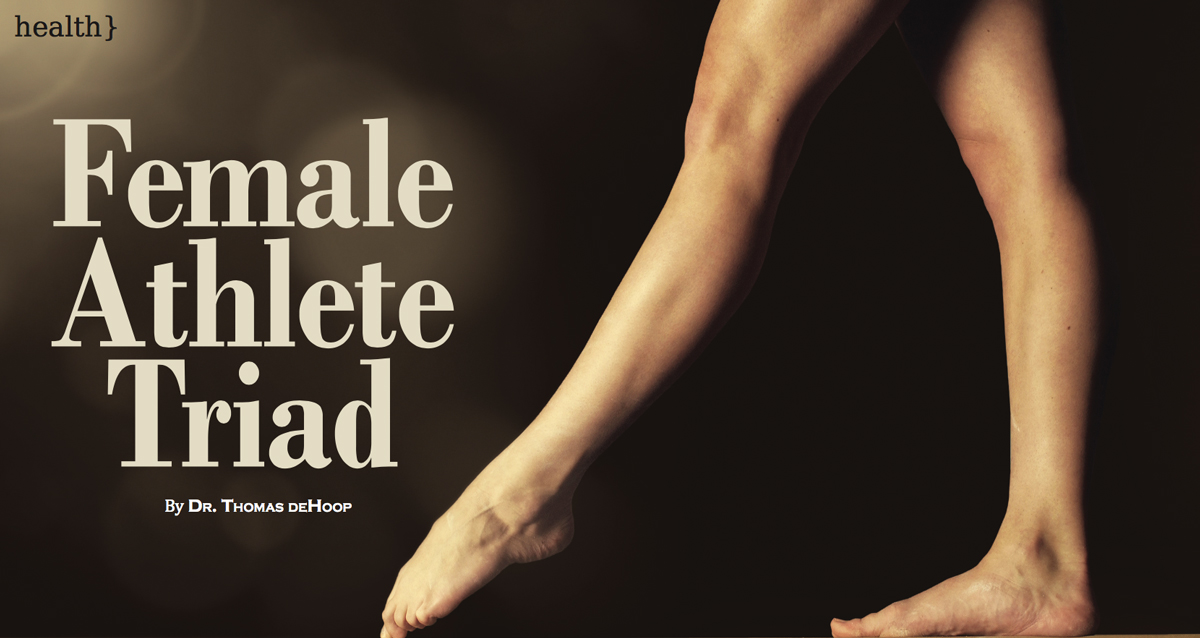Female Athlete Triad

by Dr. Thomas deHoop – Kalispell OB/GYN
Female Athlete Triad
It is hard to imagine that only 50 years ago a woman competed in the Boston Marathon for the first time. Never before have women enjoyed the benefits of regular exercise and competitive sports as they have in the past several decades. A major shift occurred in 1972 with the introduction of Title IX which states that “Any secondary or collegiate school that receives federal assistance must offer equal athletic opportunities to men and women, requiring equity in areas of participation, scholarship, dollars, and athletic benefits.”
At that time, only one out of 24 girls played high school sports, now it is approximately one in three. This has lead to significant health benefits and contributed to improved physical fitness and overall wellbeing for women. For some, however, risk exists for the development of one or more of a triad of medical disorders that has been described in the literature as the FEMALE ATHLETE TRIAD.
In 1992, the American College of Sports Medicine coined the term to describe a triad of distinct and interrelated medical conditions: disordered eating (including a range of poor nutritional behaviors such as bulimia), amenorrhea (irregular or absent menstrual periods) and osteoporosis (low bone density which can lead to weak bones or fractures).
Disordered Eating
Today, it is recognized that each of the components can express itself on the spectrum from subtle to extreme. The disordered eating seen in the triad has been better described as an energy imbalance and is the key to developing the triad. More calories are utilized than are taken in during the course of a day.
All women face societal pressure to be thin, but athletes can feel additional pressure where a lean physique and/or low body mass can confer a competitive advantage such as cross country running, gymnastics or dance. In response to this pressure to lose weight, women and girls may practice unhealthy weight-control methods, including restricted food intake, self-induced vomiting, consumption of appetite suppressants and diet pills, and use of laxatives.
Specific eating disorders are anorexia nervosa and bulimia are not as common, but all women who practice any disordered eating can progress to this extreme. As many as 75% of competitive gymnasts report a disordered eating pattern at sometime in their career. Perfectionism, compulsiveness and high personal expectations are traits of high level athletes, but also of those with eating disorders. There are psychological reasons for disordered eating. For instance, many of these athletes lead such regimented lives that their control over their diet is the only control they possess. The effects are counterproductive as they lead to impaired health, decreased performance and loss of muscle mass, often leading to injury. Eating disorders can also cause fatal cardiac complications or electrolyte imbalances. It is the responsibility of coaches, trainers, parents, friends and fellow athletes to be aware of signs of disordered eating in young athletes to avoid the consequences.
Warning signs to look for in disordered eating include
- Excessive or rapid weight loss or wide fluctuations in weight
- Preoccupation with weight, food, mealtime rituals and body image
- Avoiding team meals or secretive eating
- Extra workouts in addition to team practices
- Overuse injuries such as stress fractures
- frequent sore throats despite no infections
- Swollen cheeks from swollen parotid glands from self-induced vomiting
- Dental issues or foul breath from repeated self-vomiting
- Depression or low self-esteem, irritability or mood swings
- Yellowing of the skin
- Soft baby hair on the skin
Amenorrhea
Amenorrhea (the loss of menstrual cycles) and the less severe disorders of menstrual function are recognized to occur more frequently in female athletes than in the general population. As opposed to the 2-5% of the general population who has amenorrhea, the incidence is much higher in competitive athletes and has been reported to be as high as 40-50% in elite runners or ballet dancers. It may occur as a milder form of amenorrhea with only a few cycles missed every year. There is controversy as to the exact cause of these menstrual irregularities. The “critical mass theory” claims once a woman’s body fat falls below a certain threshold, the ovaries fail to ovulate. Others claim irregularities are due to the high level of endorphins produced during exercise that inhibit the brain’s ability to stimulate ovulation. Still others claim that the physiologic stress of exercise release stress hormones that prevent ovulation. It is likely a combination of these theories that can prevent the brain’s stimulation of the ovary to ovulate. Any female who has not begun menstruating by age 16, misses three consecutive periods or has periods that occur at an interval greater than 35 days should undergo an evaluation.
Osteoporosis
The incidence of the last component of the triad, osteoporosis, is difficult to determine since young women do not routinely undergo bone density testing because it is usually not recommended until age 65. Many young women present with stress fractures or other injuries typically seen in women of advanced age. Studies comparing bone density in young athletes found those who maintain regular menstrual cycles have greater bone density than those with irregular cycles. The bone loss is due to the lack of estrogen when there is a failure to ovulate. Since estrogen is the key to achieving and maintaining bone density, the lack of estrogen prohibits young women suffering from the triad from reaching their maximum peak bone density. This is further compounded by poor nutrition.
Long-term, these women will enter menopause with a less than optimal bone density and be at risk of osteoporosis at an earlier age. For instance, a woman at 50 years old may have the bone density of a 70 year-old woman. She will have a risk of hip and spinal fractures greater than her cohorts who had regular cycles. This exponential increased risk of the triad can be minimized or prevented.
All women face societal pressure to be thin,but athletes can feel additional pressure where a lean physique and/or low body mass can confer a competitve advantage such as cross country running, gymnastics or dance.
Prevention and multidisciplinary collaboration are the keys to success. Primary prevention involves providing the education necessary so that parents, teammates, coaches, trainers, medical professionals, communities and the athletes themselves have an awareness of the triad and can avoid practices that encourage potentially harmful behavior and intervene as necessary.
Secondary prevention involves recognizing, screening and treating subtle signs and symptoms of the triad in a multidisciplinary approach. Talk to your health care professional. Preventing and reversing bone loss can be as simple as taking an Estrogen replacement oral contraceptive medication. More severe eating disorders may involve counseling or psychiatric intervention. Young athletes should reap the benefits of regular exercise without the risk of harms that may occur as a result of disordered eating or menstrual irregularities. The goal of exercise is to maintain health so avoiding problems associated with the female athlete triad helps achieve that goal.
Dr. deHoop is a KRMC physician practicing at Kalispell OB/GYN – In 2011 he moved to Kalispell from Cincinnati, Ohio where he was an Associate Professor of Obstetrics and Gynecology at the University of Cincinnati Medical Center for 16 years. He practices general obstetrics and gynecology, with a special interest in robotic and minimally invasive surgery. He came to Kalispell with more than ve years of experience using the daVinci® robotic surgery system.
